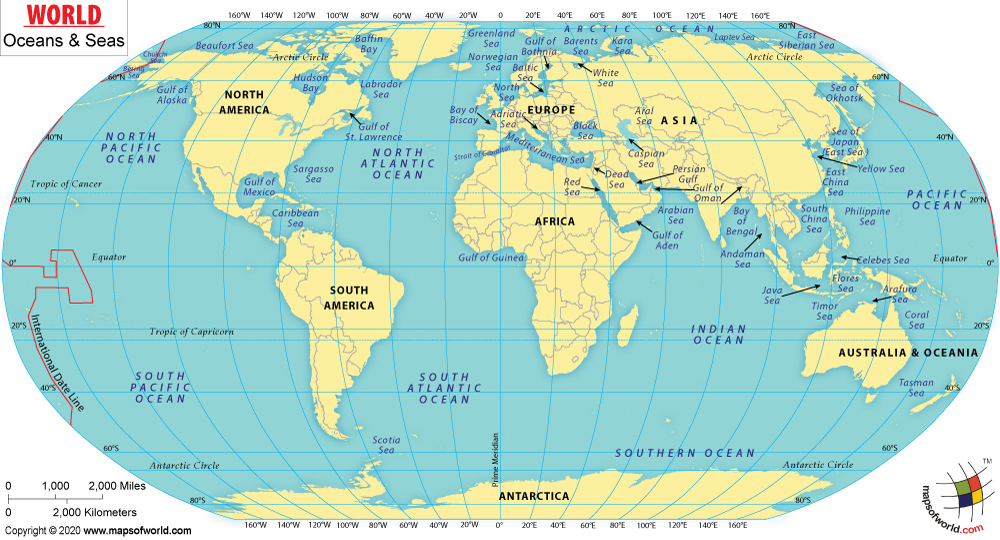World Map »
world-ocean-map
World Ocean Map

World Maps with Ocean
Though there generally are considered to be four different oceans, there are no physical divisions separating them, thus the water flowing through them is the same. The five major oceans on Earth are the Pacific Ocean, the Atlantic Ocean, the Indian Ocean, the Arctic Ocean, and the Southern Ocean.The Pacific Ocean, the Earth's largest ocean, flows to the west of the Americas and along the eastern edge of Asia. The Pacific Ocean is sometimes divided into the North Pacific and the South Pacific. The Atlantic Ocean is between the Americas and Europe and Africa, and like the Pacific, the Atlantic is also sometimes divided into the North and South Atlantic.
The Indian Ocean is situated below the Indian subcontinent, to the east of Africa and the west of Australia and the islands like Malaysia and Indonesia. The Arctic Ocean is around the north pole, and is the shallowest ocean of all - sometimes considered a sea rather than an ocean. The Arctic is encompassed primarily by North America and Russia, and its waters are partially covered by ice year-round. The International Hydrographic Organization designated the waters surrounding Antarctica to be the Southern Ocean in the year 2000, extending to the latitude of 60 degrees.
The oceans of Earth serve many functions, playing an integral role in the Earth's weather and temperature. Oceans moderate the Earth's temperature by absorbing incoming solar radiation. The continuously moving ocean currents distribute the heat energy around the globe, heating the land and air during winter cooling it during summer.
| Ocean | Area | Average Depth | Deepest Point |
|---|---|---|---|
| Pacific | 64,186,000 square miles | 15,315 feet | Mariana Trench (36,200 feet below sea level) |
| Atlantic | 33,420,000 square miles | 12,881 feet | Puerto Rico Trench (28,231 feet below sea level) |
| Indian | 28,350,000 square miles | 13,002 feet | Java Trench (25,344 feet below sea level) |
| Southern | 7,848,300 square miles | 13,100-16,400 feet | South Sandwich Trench (23,736 feet below sea level) |
| Arctic | 5,106,000 square miles | 3,953 feet | Eurasia Basin (17,881 feet below sea level) |
Ocean Facts
- The Pacific Ocean is the largest of the four main oceans
- The Atlantic Ocean is the busiest ocean. Many ships cross the Atlantic, carrying cargo between the Americas, Africa, and Europe
- The Arctic Ocean is the smallest and coldest ocean
- The average temperature of all oceans is about 39 degrees F (3.8 degrees C)
- Oceans are always moving
- Tides change twice a day all over the world, as the oceans rise and fall along the shoreline. Scientists think this is caused by the pull of the sun and moon on our Earth, and the Earth's rotation.
- Coral reefs are vast, rocky areas located in shallow, tropical waters. Coral reefs are like the tropical rain forest of the ocean in that the greatest variety of plant and animal life in the ocean live there. Coral reefs are formed from the bodies of small sea creatures called polyps
- The world's oceans contain nearly 20 million tons of gold
| Major Water Bodies |
|---|
| Top ten longest rivers | Miles |
|---|---|
| Amazon (South America) | 4,345 |
| Nile (Africa) | 4,258 |
| Yangtze (Asia) | 3,917 |
| Mississippi-Missouri (North America) | 3,902 |
| Yenisey-Angara (Asia) | 3,445 |
| Yellow (Asia) | 3,395 |
| Ob-Irtysh (Asia) | 3,364 |
| Paraná–Río de la Plata | 3,030 |
| Congo (Africa) | 2,922 |
| Amur–Argun | 2,763 |
| Top ten largest natural lakes by surface area (square miles) |
|---|
| Caspian Sea (Azerbaijan, Iran, Kazakhstan, Russia, Turkmenistan) | 143,000 |
| Lake Superior (Canada, United States) | 31,700 |
| Lake Victoria (Kenya, Tanzania, Uganda) | 26,590 |
| Lake Huron (Canada, United States) | 23,000 |
| Lake Michigan (United States) | 22,000 |
| Lake Tanganyika (Burundi, Democratic Republic of the Congo, Tanzania, Zambia) | 12,600 |
| Lake Baikal (Russia) | 12,200 |
| Great Bear Lake (Canada) | 12,000 |
| Lake Nyasa (Malawi, Mozambique, Tanzania) | 11,400 |
| Great Slave Lake (Canada) | 10,000 |
| Based on average annual total discharge |
|---|
| Rank | Name | Average annual total discharge (km3/year) |
| 1 | Amazon | 6 923 |
| 2 | Ganges | 1 386 |
| 3 | Congo | 1 320 |
| 4 | Orinoco | 1 007 |
| 5 | Yangtze | 1 006 |
| 6 | La Plata | 811 |
| 7 | Yenisei | 618 |
| 8 | Lena | 539 |
| 9 | Mississippi* | 510 |
| 10 | Mekong | 505 |
| 11 | Chutsyan | 430 |
| 12 | Ob | 404 |
| 13 | Amur | 360 |
| 14 | Mackenzie* | 325 |
| 15 | St. Lawrence* | 318 |
| 16 | Niger | 302 |
| 17 | Volga | 255 |

